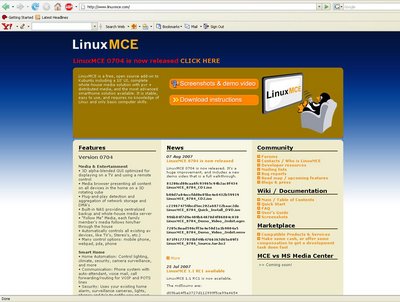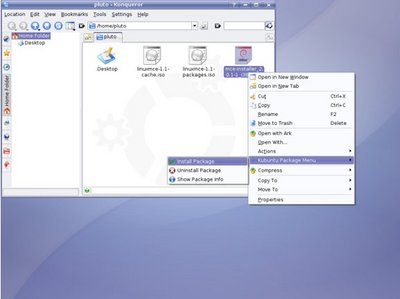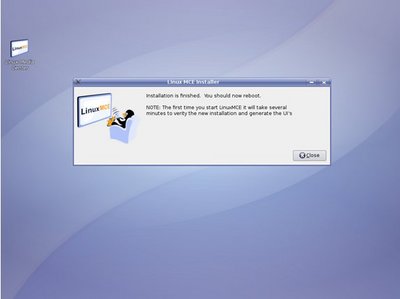Difference between revisions of "Installation Guide"
Perspectoff (Talk | contribs) (→New installation) |
Perspectoff (Talk | contribs) m (→New installation) |
||
| Line 31: | Line 31: | ||
===New installation=== | ===New installation=== | ||
If you don't already have an Kubuntu system installed, follow these generic steps to install Kubuntu Desktop 7.10 from the Live CD: | If you don't already have an Kubuntu system installed, follow these generic steps to install Kubuntu Desktop 7.10 from the Live CD: | ||
| − | # Download either the [http://releases.ubuntu.com/kubuntu/7.10/kubuntu-7.10-desktop-i386.iso 32-bit version] or the [http://releases.ubuntu.com/kubuntu/7.10/kubuntu-7.10-desktop-amd64.iso 64-bit version], depending on your | + | # Download either the [http://releases.ubuntu.com/kubuntu/7.10/kubuntu-7.10-desktop-i386.iso 32-bit version] or the [http://releases.ubuntu.com/kubuntu/7.10/kubuntu-7.10-desktop-amd64.iso 64-bit version], depending on your processor. Use the 32-bit version if in doubt. Note that LinuxMCE comes in both a 32-bit and a 64-bit version as well, so you must match. |
# If you don't know how to burn an .iso file to a bootable CD, then see [https://help.ubuntu.com/community/BurningIsoHowto these instructions]. | # If you don't know how to burn an .iso file to a bootable CD, then see [https://help.ubuntu.com/community/BurningIsoHowto these instructions]. | ||
# Boot the Kubuntu Desktop 7.10 LiveCD. | # Boot the Kubuntu Desktop 7.10 LiveCD. | ||
Revision as of 21:14, 22 April 2008
Contents
|
After installation please visit this page and fill in any information you have about the installation process. This will aid the developers in fixing any faults.
If you want to install LinuxMCE using the DVD check these steps DVD Installation
Hardware notes
See this section for general hardware recommendations.
There are two components that are best installed prior to installing the software.
For the central LinuxMCE core server, most recommended installations suggest 2 network interface cards (NICs). If you don't have a second NIC card already installed, it is easiest to do so before installing Kubuntu/LinuxMCE, since the second card can then be recognised and configured correctly during the initial installation. You won't have to fiddle with setting it up later, this way.
Also, an nVidia graphics card is strongly recommended. If you don't have one installed, it is easiest to do so before starting software installation.
Kubuntu 7.10 (Gutsy)
Note: LinuxMCE 0704beta was used only with Kubuntu Desktop version 7.04 (Feisty). The current version is LinuxMCE 0710beta and is meant to be used only with Kubuntu Desktop version 7.10 (Gutsy).
Steps for installing Linux MCE on an Kubuntu 7.10 (Gutsy Gibbon) system :
Existing Kubuntu 7.10 installation
Using the 2 CD install method (but not the DVD method) you can install LinuxMCE 0710beta on a pre-existing installation of Kubuntu 7.10, but to complete the installation you will need a Kubuntu Desktop 7.10 Live CD anyway. Make sure you have one available. (If you need to obtain one, see the next section for the download link and burning instructions.)
The install process will partially overwrite your previous Kubuntu installation using those modules from the Live CD which are known to be uniquely compatible with LinuxMCE. If you have previously modified your Kubuntu system subsequent to the original installation, you may lose some of your configuration files because LinuxMCE modifies them to suit its own needs. Therefore, do not install LinuxMCE on a mission-critical PC if you don't want to risk this. You should dedicate one PC to be the LinuxMCE core server, anyway.
New installation
If you don't already have an Kubuntu system installed, follow these generic steps to install Kubuntu Desktop 7.10 from the Live CD:
- Download either the 32-bit version or the 64-bit version, depending on your processor. Use the 32-bit version if in doubt. Note that LinuxMCE comes in both a 32-bit and a 64-bit version as well, so you must match.
- If you don't know how to burn an .iso file to a bootable CD, then see these instructions.
- Boot the Kubuntu Desktop 7.10 LiveCD.
- Choose 'Start or install Kubuntu'
- When Kubuntu's desktop appears, click on 'Install'
- A short wizard will start and guide you; Select the language and press 'forward'
- Choose your timezone and press 'forward'
- Select the keyboard layout
- Choose desktop name, a user name and a password
- Select the partitioning options for your disk: erase the entire disk or just manually edit the options.
- Ready to install.
- Reboot the system and remove the Live CD
LinuxMCE
Download LinuxMCE
From within the Kubuntu 7.10 desktop, open Konqueror or Firefox (the orange and blue icon at the top), and go to www.linuxmce.com and select 'Download Instructions' to download the LinuxMCE CD`s or the DVD on your machine. You can also just download directly from this link.
Note that there is a 32-bit version and a 64-bit version of LinuxMCE. If you are using a 64-bit Kubuntu 7.10 installation, download the corresponding LinuxMCE version.
Burn download to CDs and install from CDs
If you don't know how to burn an .iso file to a CD then see these instructions.
Burn the two CDs (assuming you are using this method).
You can then simply place CD 1 in the CD-ROM and the installer will autostart. You will be prompted to put CD 2 in the drive, followed by your Kubuntu Desktop Live CD.
The rest will take a lot of time but will essentially install automatically.
Installing mce-installer from KDE Menu
Once you have downloaded the packages, proceed with the installation. First, you have to install mce-installer, which is the software that will guide you through the installation. Right-click on it, go to Kubuntu Package Menu -> Install Package.
Installing mce-installer from command prompt
Alternatively, you can install the mce-installer from a command prompt without the need to burn the ISOs as follows:
cd /directory/where/the/downloaded/iso/files/are/ mkdir -pv mnt sudo mount LinuxMCE_0704_CD1.iso mnt/ -o loop sudo dpkg -i mnt/mce-installer_2.0.1-1_i386.deb sudo umount mnt rmdir -v mnt
Install LinuxMCE
The installer will have put an "Install LinuxMCE" icon on your desktop. Click it to start the installation process. A window will appear saying that you will be notified when updates are available.
Choosing type of Core
After this you have to choose if you want a dedicated core or a hybrid (click hereto find out the difference between a core and a hybrid), and then click on "Forward" button.
Choosing Video Card
- Only for Nvidia cards - LinuxMCE will detect that you are using a nVidia Card, but you are not using the proprietary video driver. Only that driver works well with LinuxMCE and nvidia cards and it will ask you it you want to switch to it now.
Network Configuration
The next screen will ask you want to keep your current network configuration or if you want to set your network options manually; then press "Forward".
And then you must set your network using static IP or DHCP
Choosing Mirror for Packages
You have to choose a mirror
Choosing DHCP Server
In the next step you have 2 options :
- First it asks you if you want to Run a DHCP Server or not. LinuxMCE must be the DHCP server for your home in order to provide plug-and-play detection of network devices like IP Cameras and VOIP phones, and to provide network boot images to any other pc's in the home you want to use as media stations.
- The other option asks if you want to keep the default Internal Network address or if you want to change it. If you have already a DHCP-Server running, choose also this option. You can then switch from 'manually' to 'DHCP'.
After that you must press 'Forward'.
Choosing Orbiter Interface
In the next window you need to choose what interface you want to use and you have to pick one of three possibilities. There are currently three options: UI1, UI2 with masking, and UI2 with alpha-blending. UI2 requires specific video cards. It is best to choose UI1 for the initial installation as the interface can be changed later. This will reduce the possibility of video card related errors during installation. After installation, you can check to see if your video card can do masking and alpha-blending by following the instructions at Graphics Test
Installing Additional Packages
On the next step you have to choose if you want to install lame and libdvdcss and if it is legal in your country to use them.
Choosing How to Primarily Use the Computer
You have to select how do you plan to use your computer: Primarily used as a PC- you can start LMCE manually when you need it or A dedicated LinuxMCE and you can start Kubuntu when you need it.
Installing LinuxMCE Discs
This step is very important you have to insert
LinuxMCE DISC 1
LinuxMCE DISC 2
Kubuntu 7.10 Live CD
You can see the message about the Linux MCE system installation.
Installation can take a long time
Don't worry if the system seems to stop at points or report what seems like error messages. This is normal since at places it will be testing drivers out, and is only there for the advanced Linux user. You will get a dialog box if something really does go wrong. And, understand this may take a very long time since it will in parallel be updating your Kubuntu system to the latest version. Just leave it for an hour or two and come back later.
Installation Complete
After the installation is done you’ll receive a message from the installer that will tell you to restart the system
Next follow the QuickStart Guide to tell LinuxMCE about how you want to use it.
Additional Notes
Note that if you said you want LinuxMCE to startup by default, after rebooting you'll have LinuxMCE, not Kubuntu. If you will only use this as a media pc, that's fine; you won't ever need to access the Kubuntu desktop to set anything up and can do it all from either the LMCE UI and a remote control, or with the LMCE web admin panel using the web browser of any pc in your home. But, if you want to use this as a normal Kubuntu PC too, and you want to start Kubuntu after LinuxMCE is going, there's not yet an icon to switch to Kubuntu from within LinuxMCE, so press Ctrl+Alt+F2, login, and type StartX. If you said you want Kubuntu by default, it will boot to the Kubuntu desktop and you can choose Applications, Sound & Video, Start Media Center to start LinuxMCE manually. When both LinuxMCE and Kubuntu are running, you can toggle between them by pressing ctrl+alt+f7 for Kubuntu and ctrl+alt+F11 for LinuxMCE. Unfortunately, at this moment, once you start LinuxMCE there is no way to stop it. The Kubuntu integration is still a work in progress.
















